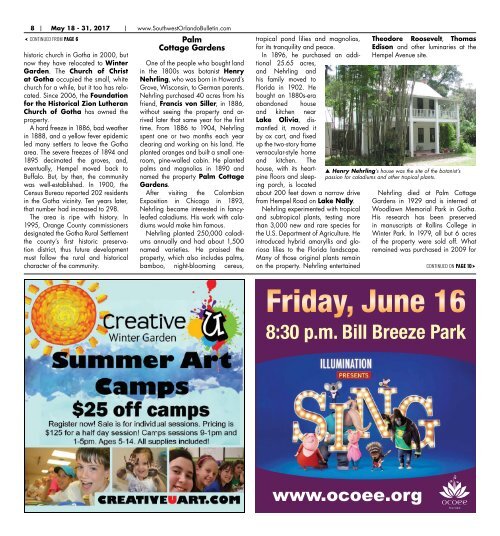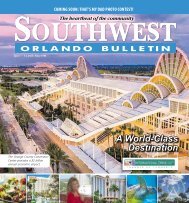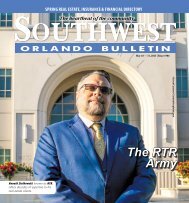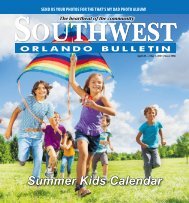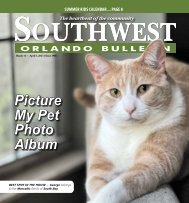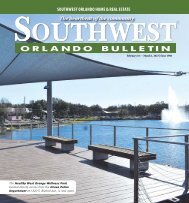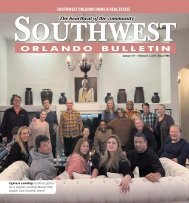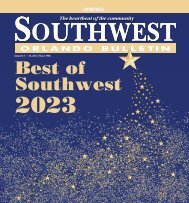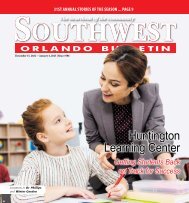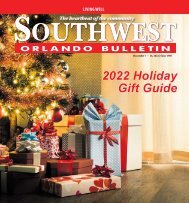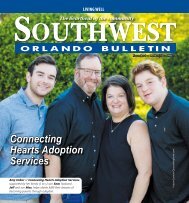You also want an ePaper? Increase the reach of your titles
YUMPU automatically turns print PDFs into web optimized ePapers that Google loves.
8 x May 18 - 31, 2017 x www.SouthwestOrlandoBulletin.com<br />
CONTINUED FROM PAGE 6<br />
historic church in Gotha in 2000, but<br />
now they have relocated to Winter<br />
Garden. The Church of Christ<br />
at Gotha occupied the small, white<br />
church for a while, but it too has relocated.<br />
Since 2006, the Foundation<br />
for the Historical Zion Lutheran<br />
Church of Gotha has owned the<br />
property.<br />
A hard freeze in 1886, bad weather<br />
in 1888, and a yellow fever epidemic<br />
led many settlers to leave the Gotha<br />
area. The severe freezes of 1894 and<br />
1895 decimated the groves, and,<br />
eventually, Hempel moved back to<br />
Buffalo. But, by then, the community<br />
was well-established. In 1900, the<br />
Census Bureau reported 202 residents<br />
in the Gotha vicinity. Ten years later,<br />
that number had increased to 298.<br />
The area is ripe with history. In<br />
1995, Orange County commissioners<br />
designated the Gotha Rural Settlement<br />
the county’s first historic preservation<br />
district, thus future development<br />
must follow the rural and historical<br />
character of the community.<br />
Palm<br />
Cottage Gardens<br />
One of the people who bought land<br />
in the 1800s was botanist Henry<br />
Nehrling, who was born in Howard’s<br />
Grove, Wisconsin, to German parents.<br />
Nehrling purchased 40 acres from his<br />
friend, Francis von Siller, in 1886,<br />
without seeing the property and arrived<br />
later that same year for the first<br />
time. From 1886 to 1904, Nehrling<br />
spent one or two months each year<br />
clearing and working on his land. He<br />
planted oranges and built a small oneroom,<br />
pine-walled cabin. He planted<br />
palms and magnolias in 1890 and<br />
named the property Palm Cottage<br />
Gardens.<br />
After visiting the Colombian<br />
Exposition in Chicago in 1893,<br />
Nehrling became interested in fancyleafed<br />
caladiums. His work with caladiums<br />
would make him famous.<br />
Nehrling planted 250,000 caladiums<br />
annually and had about 1,500<br />
named varieties. He praised the<br />
property, which also includes palms,<br />
bamboo, night-blooming cereus,<br />
tropical pond lilies and magnolias,<br />
for its tranquility and peace.<br />
In 1896, he purchased an additional<br />
25.65 acres,<br />
and Nehrling and<br />
his family moved to<br />
Florida in 1902. He<br />
bought an 1880s-era<br />
abandoned house<br />
and kitchen near<br />
Lake Olivia, dismantled<br />
it, moved it<br />
by ox cart, and fixed<br />
up the two-story frame<br />
vernacular-style home<br />
and kitchen. The<br />
house, with its heartpine<br />
floors and sleeping<br />
porch, is located<br />
about 200 feet down a narrow drive<br />
from Hempel Road on Lake Nally.<br />
Nehrling experimented with tropical<br />
and subtropical plants, testing more<br />
than 3,000 new and rare species for<br />
the U.S. Department of Agriculture. He<br />
introduced hybrid amaryllis and gloriosa<br />
lilies to the Florida landscape.<br />
Many of those original plants remain<br />
on the property. Nehrling entertained<br />
Theodore Roosevelt, Thomas<br />
Edison and other luminaries at the<br />
Hempel Avenue site.<br />
Henry Nehrling’s house was the site of the botanist’s<br />
passion for caladiums and other tropical plants.<br />
Nehrling died at Palm Cottage<br />
Gardens in 1929 and is interred at<br />
Woodlawn Memorial Park in Gotha.<br />
His research has been preserved<br />
in manuscripts at Rollins College in<br />
Winter Park. In 1979, all but 6 acres<br />
of the property were sold off. What<br />
remained was purchased in 2009 for<br />
CONTINUED ON PAGE 10<br />
Friday, June 16<br />
8:30 p.m. Bill Breeze Park<br />
www.ocoee.org


